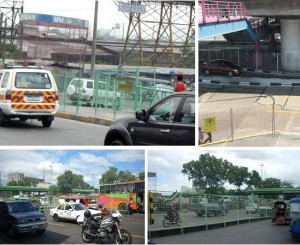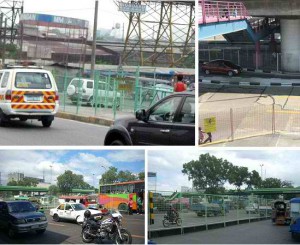By RIZIEL ANN AGALOOS CABREROS and CAMILLE PABLO DE JESUS
(Part 1)

SINCE the start of the year, the once all-pink wire mesh fences and footbridges along Metro Manila’s major roads have been gradually repainted green in line with the Metro Green project of the Metro Manila Development Authority (MMDA) under its new chair Oscar Inocentes.
The greening of MMDA’s fences has been criticized for allegedly being politically motivated, especially because green is the signature color of Gilbert Teodoro, presidential bet of the ruling Lakas-Kampi-Christian Muslim Democrats Party. The color change began almost at the onset of the election campaign.
The Commission on Elections (Comelec) has, in fact, warned the MMDA, an agency directly under the Office of the President, of the “unfair advantage” that its new color scheme gives Teodoro.
But MMDA officials said the color just happens to be the personal favorite of Inocentes, who has been described in news reports as a “recreational farmer.”
“Green ang color ngayon,’yun na (Green is the color now. That’s it),” said Edenison F. Fainsan, MMDA assistant general manager for finance and administration, when asked about the sudden change in MMDA’s color identity.
Last January, Inocentes’ Metro Green campaign replaced former MMDA chair Bayani Fernando’s Metro Gwapo theme, and the once-pink fences, footbridges, urinals, tree guards and other infrastructure projects began turning green.
Fernando had earlier resigned as MMDA chief and Lakas-Kampi-CMD member after he failed to get the nomination to be the standard-bearer of the party which chose Teodoro. Fernando eventually gave up his presidential bid, and later joined Richard Gordon as his running mate for The Transformers tandem.
The MMDA acknowledges that the fences as well as the color pink were Fernando’s idea. Fainsan said the color pink helped create the MMDA’s identity as well as publicize and popularize its activities.
But MMDA officials would rather give the credit to their other boss, President Gloria Macapagal-Arroyo. “She has funded us significantly by over thousands percent compared to the other presidents,” MMDA General Manager Robert C. Nacianceno said in an interview.
“(In previous administrations), the most that (we) could get from the Office of the President was, if I remember right, around three million (pesos) at the most. Now, we are receiving hundreds of millions… In a year’s time, we have received from the presidential social fund over a billion,” Nacianceno added.
The MMDA has worked closely with Arroyo since Fernando’s term as chair, as seen in many tarpaulins, streamers and political advertisements showing the President and Fernando together in many infrastructure projects.
On Oct. 8, 2003, the MMDA procured through emergency purchase P91,200 worth of tarpaulins carrying pictures of Arroyo and Fernando. Those tarpaulins were hoisted in time for the visit of then US president George W. Bush to the Philippines on Oct. 19, 2003. Fainsan said the MMDA considers it part of its mandate to obey President Arroyo’s orders.
Fernando started the construction of the pink wire mesh fences in 2003 as a road safety and traffic management tool to deal with the growing number of vehicles on Metro Manila roads.
A mechanical engineer by profession, Fernando himself designed the six-foot fences, which now span some 500 kilometers. Part of the fences’ design was the use of the color pink which the MMDA adopted in its projects and campaigns.
Fernando explained in an interview with Probe’s Profiles that he first used pink as the color of Marikina during his term as mayor, in line with the motto, “Marikina City ‘in the pink of health.’” That was when the World Health Organization chose Marikina as the center for the Healthy Cities’ Initiative.
He decided to continue using pink when he became MMDA chair to spread the Healthy Cities’ Initiative to the whole of Metro Manila.
Regardless of the criticism thrown at the MMDA’s pink-turned-green fences, some still believe the project has its benefits.
Economist Solita Monsod, former chief of the National Economic and Development Authority, said the MMDA’s projects are a big help to traffic and infrastructure development. She said the pink urinals, fences and footbridges “contribute greatly to the reduction in traffic time…accidents, and…the lessening of the stink.”
The MMDA fences were primarily installed to impose discipline on Metro Manila drivers and pedestrians.
“Before the pink fences, people (would) just cross the major thoroughfares like EDSA, (and) commuters would go down in the street and wait for public utility vehicles on the street itself, and that shouldn’t be,” Nacianceno said.
He said the fences also help reduce the number of road accidents and crime because they prevent traffic rule violators, jaywalkers and snatchers from easily crossing the road.
But despite these perceived benefits, Jose Regin F. Regidor, director of the University of the Philippines National Center for Transportation Studies, said “the pink fences represent increased roadside friction” as the structures’ design divides roads into tight lanes which make them harder to navigate, especially for drivers not skilled enough to go through narrow ways.
Moreover, he said the fences “limit the movement of emergency vehicles.” When a vehicle gets trapped, it becomes fenced in the lane so there is no way out.
The use of the color pink in road signs and structures such as the MMDA fences was also criticized for allegedly violating the United Nations Vienna Convention on Road Traffic and Road Signs and Signals to which the Philippines is a signatory.
The convention limits the colors to be used in specific elements of road signs to white, yellow, red, blue, green, black and orange, depending on their purpose and location. However, no specific provision in the convention pertains to road structures such as wire mesh fences.
And what about the fences’ green color of today?
Although green is included in the 1968 Vienna Convention on Road Signs and Signals, it is to be used only for traffic lights and not for road structures. (To be concluded)
(The authors are journalism seniors at the University of the Philippines College of Mass Communication. This report is based on the thesis they submitted to their adviser, VERA Files trustee Yvonne Chua.)
